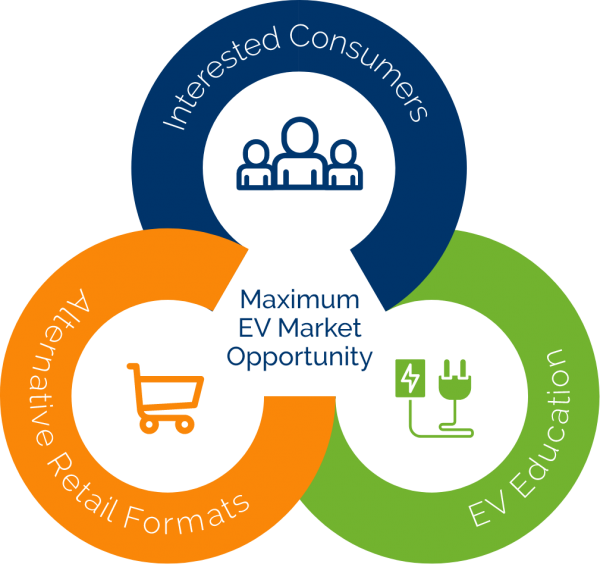How to Cash In on the EV Trifecta: Interested Consumers, EV Education, and Alternative Retail Formats
The automotive industry is undergoing revolutionary change driven by a combination of government and regulatory pressures, environmental concerns, and growing consumer sentiment. Although EV sales remain in the low single digits, the inevitability of an electrified automotive future is fast approaching.
How will automakers cash in on the significant investments needed to change the mix of their vehicle lineups from ICE to EV? By making sure consumers are both excited and educated about EV possibilities, and by augmenting the selling process through Alternative Retail Formats.

Turning EV Interest into Next-Purchase Consideration
Consumer interest in EVs is on the rise. In a nationally representative survey of American adults with a valid driver’s license, 71% said they had at least some interest in getting an electric vehicle at some point, and 31% said they would consider an EV for their next purchase or lease.1
Percent Interested in Purchasing an EV at Some Point –
by Generation
78%
of millenial drivers
70%
of Gen X drivers
66%
of Baby Boomer drivers
58%
of Silent Generation drivers
The challenge of turning that interest into consideration received a major boost in early August when President Biden signed an executive order with a nonbinding target for zero-emission vehicles — battery-electrics, plug-in hybrids and fuel cells — to make up half of all new passenger vehicles sold in 2030.2 Major automakers, including the Detroit 3, Toyota Motor North America and Volkswagen Group of America, joined the president as he signed the order outside the White House.
The obstacles in moving from ICE to EV have been well documented: cost, range and lack of an infrastructure of rapid charging stations. The pandemic, however, added a fourth variable into the mix: the impact of remote work on consumer driving habits, and the implications on EV adoption going forward.
In a recent FlexJobs survey, 3 38% of workers estimate they would save at least $5,000 a year from remote work. Although remote work is one small factor helping pave the way for an electrified future, plenty of attitudinal and infrastructure hurdles still remain. Overcoming those hurdles and turning interest into consideration starts with education.
1/3 of survey respondents state their reason for not considering EV is a lack of knowledge.
EV Education –The Move from Selling to Telling
Consumers harness information from online and offline resources in their decision-making process and — according to a recent Urban Science Harris Poll4 survey — 84% trust the automotive manufacturers who provide that information.
That same poll, however, reports that consumers are demanding a low-pressure sales experience when buying a car. It’s not trust, but rather hard-sell methods that are driving consumers away during the initial stages of investigation — regardless of the type of new vehicle being shopped.
A recent survey published in Nature Energy further quantifies the problem, with consumers reporting that salespeople — two-thirds of the time — strongly steered potential customers away from EVs (even at dealerships with EV inventory in stock).5 That same survey found that in 71% of dealership visits, salespeople exhibited low or no knowledge of EVs.
Dealers who show reluctance to embrace an EV future are clearly missing out. One in three respondents in a recent J.D. Power study state the reason shoppers give for not considering an EV purchase is a lack of knowledge.6 That same study finds that — although 50% of the car-buying population has never been in an EV, once they gain firsthand experience with one, their consideration nearly triples: from 7% to 20%.
Consumers are demanding a low-pressure sales experience when buying a car — Alternative Retail Formats offer a space for education and experience in line with consumer demands.
Alternative Retail Formats –Transaction Transformation Starts Here
Automakers across the country realize that education is only the beginning. Alternative Retail Formats take EV shopping to the next level, where OEMs can better control the experience with well-trained, knowledgeable and motivated sales consultants. They offer an educational space that — at their best — are non-pressured environments in line with what today’s shoppers want. Not surprisingly, then, there are a number of Alternative Retail Formats under consideration. That includes test-drive and experience centers, boutique and pop-up stores, and more.
There are two realities, however, facing even the most forward-thinking automotive manufacturers: 1) It takes time to change customer engagement tactics; and 2) regardless of all other factors, the demand to sell vehicles is ongoing. So how do you get to where you need to be? By using purpose-built, strategic planning tools to analyze consumer demands, geography and demographics that meet potential customers where they are — and in a format they want.

Find the consumer where they are with a retail format they desire.
Given the investment costs necessary for Alternative Retail Formats, it is critical to take into account the factors that go with the decision to move forward, including a clear definition of the mission, intelligent placement and an up-front determination of how success will be measured.
What can be done in the interim to help move those interested in EVs to considering them for their next purchase? According to the Urban Science Harris Poll mentioned earlier, that’s where test drives come in — something that shoppers in every age group but one list as the top, preferred method of brand engagement. And the one group that doesn’t give it the number one spot — 25–34-year-olds — still ranks it second. Dealers who ensure the EVs they have on hand for test drives are charged up and ready to go may be pleasantly surprised at the results — across all age groups.
The Objective Power of Science
自四十多年前成立以来,我们经过验证的科学规划方法一直在不断改进和发展。这种方法始终走在技术前沿,帮助 OEM 提高其经销商网络的绩效,并继续成为行业标准。
If you’d like to talk to someone at Urban Science about your EV challenges, call or email me. And let us show you how we can apply the power of science to your challenges.

西蒙·布拉德利
城市科学网络全球实践总监
slbradley@urbanscience.com
+1-562-988-4262
- Consumer Reports Electric Vehicles and Fuel Economy Survey, https://article.images.consumerreports.org/prod/content/dam/surveys/Consumer_Reports_Electric_Vehicles_Fuel_Economy_National_August_2020
- Biden EV Target Sets Destination for Industry, https://www.autonews.com/regulation-safety/biden-ev-target-sets-destination-industry
- Future of Work: What the Post-Pandemic Workplace Holds for Remote Workers’ Careers, https://www.forbes.com/sites/bryanrobinson/2021/05/02/future-of-work-what-the-post-pandemic-workplace-holds-for-remote-workers-careers/?sh=471f25b97f5b
- Urban Science Online Consumer Study, June 2021. This survey was conducted by The Harris Poll on behalf of Urban Science among 2,067 U.S. adults age 18 and older.
- Zarazua de Rubens, G., Noel, L. & Sovacool, B.K. Dismissive and deceptive car dealerships create barriers to electric vehicle adoption at the point of sale. Nat Energy 3, 501–507 (2018). https://doi.org/10.1038/s41560-018-0152-x
- JD Power Suggest Outreach and Education to Build EV Demand, https://insideevs.com/news/504167/jd-power-ev-demand-education/
